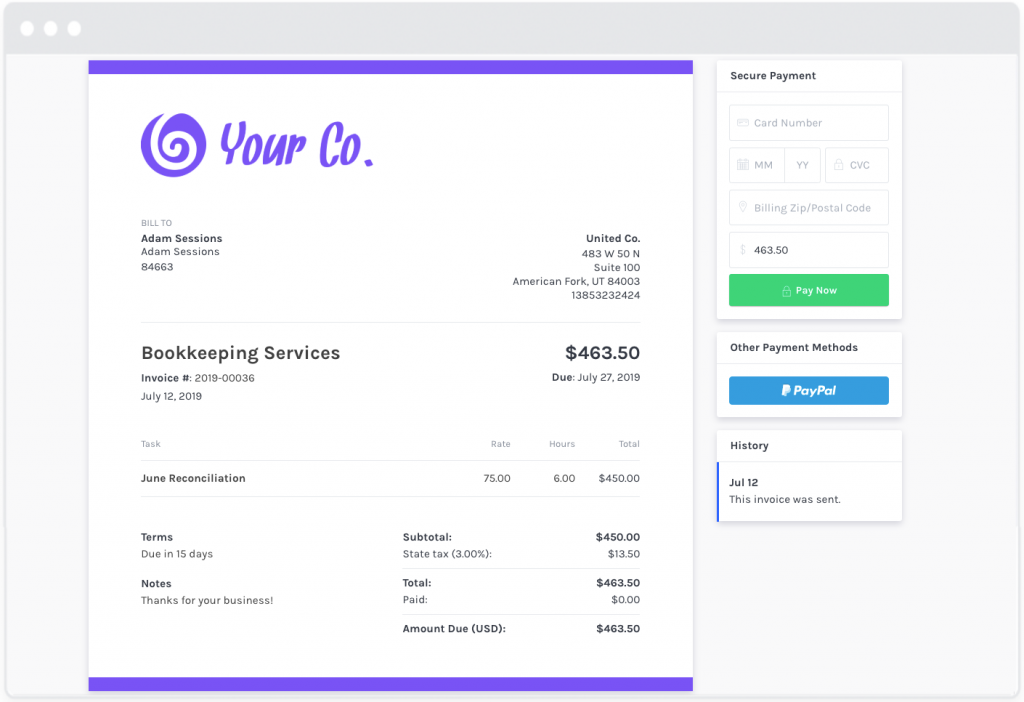by Zipbooks Admin
How to get started in freelance digital marketing (and rock at it)

The 9 to 5 is a thing of the past. Odds are, you stumbled across this article because you’re dissatisfied with toxic company culture. Or you want more freedom to travel. Or you’d like to choose your clients. Or maybe you’re just tired of listening to Craig slurp down his yogurt everyday.
Whatever the reason—take heart. The world of freelance is only growing and it’s a lifestyle anyone can build.
What do freelance digital marketers do?
As a freelance digital marketer, your job is promote the businesses of your clients in a way that brings in new customers. Digital marketing includes copywriting, content writing, search engine optimization (SEO), advertising, social media management and more.
What will my day-to-day look like?
Your day-to-day as a freelance digital marketer will look different depending on the niche you choose. For example,
- If you’re Copywriting, you might create landing pages, draft emails, or improve CTAs.
- If you’re creating Content, you might write blogs, design case studies, or script podcasts.
- If you’re doing SEO, you might build backlinks, research keyword ideas, or audit websites.
- If you’re managing Social Media, you might edit photographs, create infographics, or engage with followers.
More generally, a digital marketer’s day-to-day might include setting up KPIs, perfecting marketing strategies, sending reports to clients, measuring analytics, and creating other promotional materials (newsletters, onboarding, outreach, ads, etc).
Typically, freelance marketers will organize their time by client or project.
How much do freelance digital marketers make?
Digital marketer salaries float around $61K (according to Glassdoor) or around $25/hour (according to ZipRecruiter).

As a freelance digital marketer you will set your own rates (here’s how), but you can quickly scale to this amount or higher if you hustle, find the right clients and build your expertise.
While education or experience in marketing would be an incredible boon to someone trying to start their own digital marketing business, it’s not required. Clients will care more about what you have to show for yourself.
Here’s how to get started:
1. Drill down
Digital marketing is a wide and varied field. It combines old fashioned practices like advertising and design with modern channels like social media and search engines.
When getting started, it can be tempting to do it all. You’ve got tons of marketing experience under your belt after all: design skills, editing skills, photography skills, nunchuck skills.
But you’re not working at an agency anymore. As a freelancer, you’ll land more clients if you can niche down.
Bring your background into your business and consider your target audience. You know that you can market yourself better if you actually know what services you’re offering and what clients you want.
Plus, then your client will actually know what they’re getting. I’ve seen too many freelance marketers lose business overnight because their clients don’t understand the scope of what they’re buying. Set very clear expectations about the marketing tasks you’ll be doing and the results they might see.
And always include time frame in your initial project descriptions—clients likely won’t understand that some marketing (like SEO and content) is a long game, not a get-rich-quick scheme.
Choosing your niche
When it comes to freelance digital marketing, I recommend specializing in one of the following:
- SEO
- Copywriting
- Content writing
- Social media management
Important reminder: there will inevitably be overlap in these fields (you know that), but choosing just one area to focus on will attract the right customers.
Think about which aspect of marketing comes most naturally to you—what you do well and get excited about. This is the best niche for your business.
For example, I’d take content writing over copywriting 9 times out of 10. If your marketing strengths lie in imagery, design and engagement, social media might be a better field for you. If you like the research, outreach and strategy associated with SEO, start there.
You may find that clients request multiple services from you—because they like you and you’re killing it! If this is the case, you can still create a one-stop digital marketing shop, just outsource. If you’re great at social media management, but a client requests a website update, hire a freelance programmer to help you out. Easy.
2. Build your portfolio
Once you’ve chosen your niche, don’t quit your day job. Not yet at least. First you need to show off a little.
Start creating a collection of projects, posts, pictures and other content that applies to your niche. In addition to physical examples, make sure you have some statistical examples as well. Data that proves tangible ROI will impress clients more than pretty pictures.
If you find that your portfolio is a little lean, do something about it! Create some mock-ups for your favorite company or offer to work for free for friends and family. These experiences, products and even testimonials (don’t forget to ask for them!) will help you bring in more clients later.
Showcase your portfolio on a beautiful website. Put some real time and money into your website. This is your first impression to clients. It should be engaging, mobile-friendly and fully-optimized.
Then, make it easy for clients to contact you. One short form, accessible from any page.
3. Put yourself out there
Just because you have a hefty portfolio, doesn’t mean clients will flood your contact form. They need to be able to find you first.
Put your marketing background to work and do some good old fashioned SEO for your own company. Optimize for keywords and create content that potential clients would be looking for.
If your services are contingent upon a certain region, make sure you claim your Google My Business profile. This will optimize your business for “near me” searches and get you to the top of Google search results.

 According to Moz, signals from Google My Business are the most important ranking factor for local SEO
According to Moz, signals from Google My Business are the most important ranking factor for local SEO
Create valuable content and offer it for free. Actively participate in marketing groups and forums. Don’t just promote yourself, be genuinely helpful. Write your own marketing course. Pitch out to online publications. Become a speaker.
Don’t reinvent the wheel. You know the tricks of the trade—now just market yourself—Catch attention. Earn trust. Acquire customers.
4. Get paid
Despite all your hours of marketing efforts, you may still have to go on the hunt for paying clients.
There are tons of online platforms for freelancers to find projects and bid for clients. Upwork is a popular favorite, but it does have a cumbersome enrollment process and takes between 10-20% of your earnings (though most sites like this will take some sort of cut).
Other freelance sites worth perusing:
If you are not interested in using third-party sites to secure clients, there is another way: leverage your own network. This is definitely a more long-term strategic play, but the clients you secure are more likely to be loyal.
Don’t overthink it. Look for newer or smaller businesses who are willing to work with a novice freelancer like yourself. Remember, the first client is the hardest to get, but if you do stellar work, it will only get easier.
Setting your rates
On to the question that gets most freelancers biting their nails off—how much should I charge?
Setting your rates doesn’t have to induce nightmares. One of the advantages of being your own boss is that you can change rates whenever—even between clients if you have to! Just start somewhere.
Most beginners start with an hourly pricing model, but you have some flexibility here. You could also consider charging by project, by milestone or even by retainer.
Look around at other freelance digital marketers—how much are they charging? Take into account what your goals are and how much you need to pay the bills. And of course, make sure that you’re delivering actual value.
To determine your basic pricing, you need to figure out what your target annual income is first. Then, adjust that salary based on expected business expenses (including ~30% for self-employment taxes). Finally, divide by the number of hours you expect to work in a year.
Here are a few other easy ways to set hourly rates:
- Drop three zeros—Take your goal salary and drop three zeros (e.g. $50,000/year = $50/hour)
- Double your resentment number—What’s the lowest rate you’ll work for (so low that you’ll resent your work)? Double it. (e.g. $15/hour * 2 = $30/hour)
- Do what the next guy does—Google average hourly rates for freelance digital marketing or check out competitor pricing.
Once you’ve set your rates, post them clearly on your website (even it’s just an estimate). You’re not locked in to your rates; businesses change pricing all the time. If a certain client requires more attention, up your price. Or If you’re really excited to work with someone, consider offering a discount.
Don’t take on broke clients though. If they’re barely making a living themselves, you may end up chasing down payment or getting fired because—it’s not you, it’s them.

And if you do use hourly rates, make sure you have a decent time tracker so that clients know exactly what they’re paying for. For example, ZipBooks is free accounting and time-tracking software that allows you to import billable hours directly into your invoices, so you never forget to get paid.
5. Know your numbers
Now, for the part of freelancing that you’re least excited about: accounting.

Wait—don’t skip this section! I know your books may not excite you, but you need accurate financial records to make sure that your business is actually staying afloat.
Separate business spending
Start by setting up a separate bank account for your business transactions. You don’t need to go out and get a fancy metallic credit card; just open a new checking account at your current bank.
Freelance digital marketers are often sole proprietors who don’t see a need to separate spending or find it easier not to transfer funds. However, there are strict tax laws related to personal draws and blended funds will raise red flags for the IRS.
While this may seem like an unimportant step in your business growth, intermingling spending habits will create messy books and be a nightmare come tax time.
If self-employment taxes are already freaking you out, check out our guide here. In a matter of words, self-employed individuals are required to pay estimated quarterly taxes 4 times a year—not just in April. But you do get awesome deductions!
Use smart software
As the right-brained creative that you are, you owe it to yourself to find a smart, beautiful, automated accounting solution.
The standard today is cloud-based accounting software that can go anywhere with you and integrates with every service you need—time-tracking, payment processing, digital invoicing, and more.

The customer view of a ZipBooks invoice
ZipBooks free Starter plan offers unlimited invoicing that integrates with popular payment processors like Square and PayPal so you get paid faster. Clients make payments online and transactions are automatically imported into books—meaning less mundane accounting work for you.
6. Run a business
You did it. You’ve started a business—now run one!
Create a mission statement and set revenue goals. Not only will setting milestones help you to grow your business, but it will improve your relationships with clients. Don’t disappoint your clients with overblown promises, but be realistic as you set expectations of project duration and quality. Meeting expectations consistently is better than underdelivering on lofty promises.
Freelancing can get a little overwhelming, especially if you’re new to it or you’re taking on lots of new clients. Make a calendar and stick to it. Don’t let friends or kids or anything else distract you during working hours. Of course, the beauty of freelancing is that you get to set when those working hours are, but make sure you honor your schedule. If you don’t value your time, your clients won’t value it either. Be hyper organized. And don’t procrastinate!

Calendar Blocking for increased productivity
Remember, done is better than perfect. Just go for it. You’ll figure things out along the way.
And if you’re suffering from imposter syndrome—(Hello, High School English teacher here!)—just keep hustling. Constantly check in with yourself. Keep learning, keep practicing. Enough confidence and ambition will carry you a long way.
You may be a one-man (or woman) show, but that doesn’t mean you can neglect business imperatives like customer service or your own marketing efforts. Build relationships with the people around you. Be outgoing and be kind. Keep in touch with your audience through an email list, facebook group, twitter profile, etc. The more people you have on your side, the more your business will grow.
You’re the employer now, not the employee. Go out there and slay.
For my veteran freelance marketers out there, I want to hear from you! Tell me in the comments—What worked for you as you were getting started? What would you do differently a second time around?






